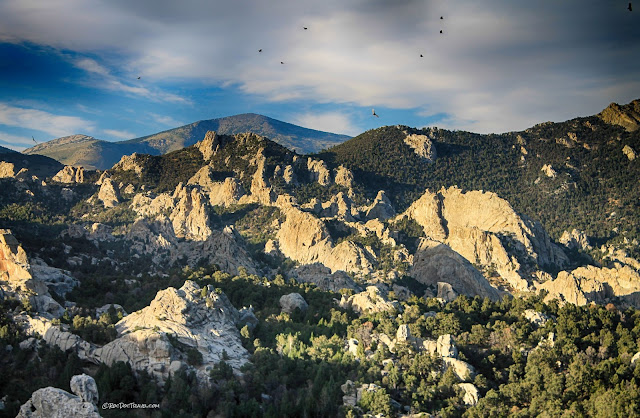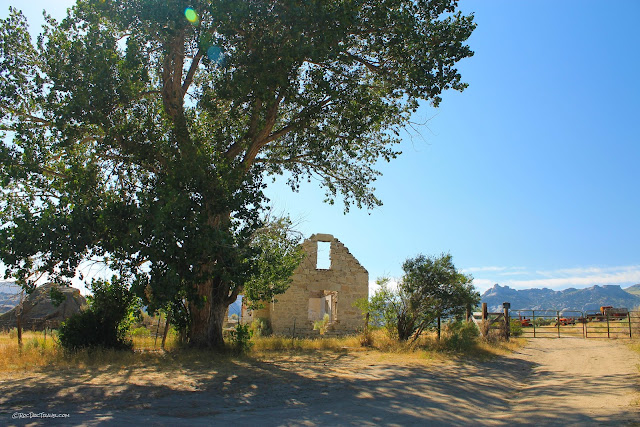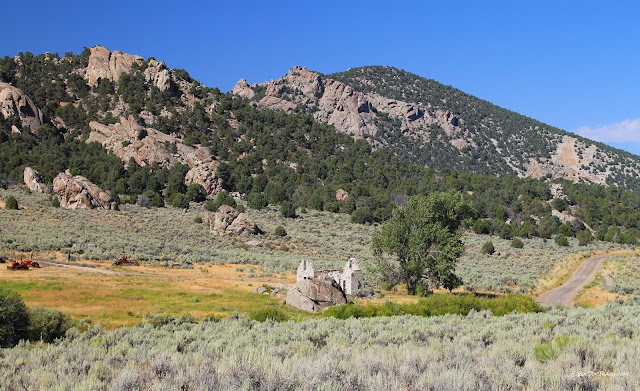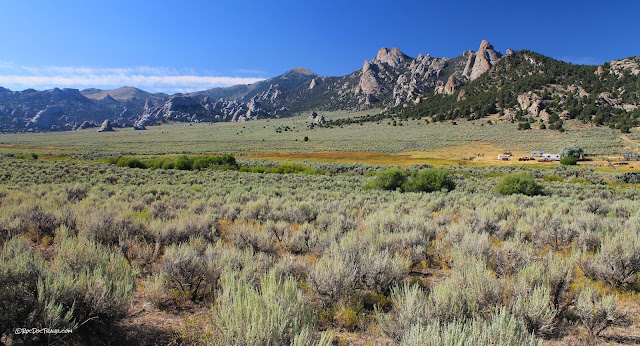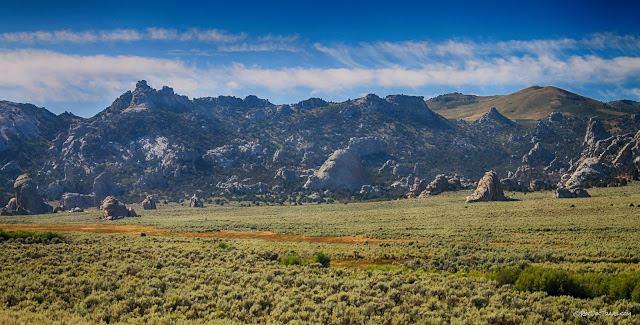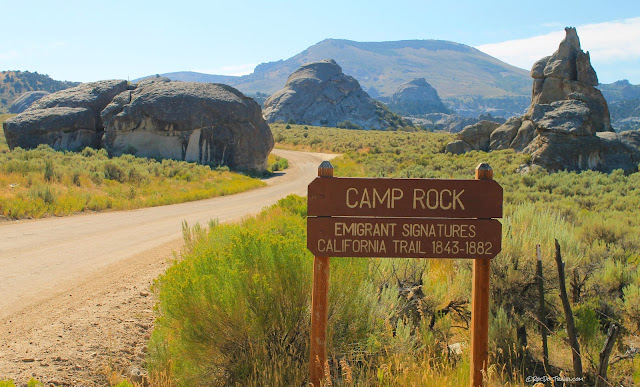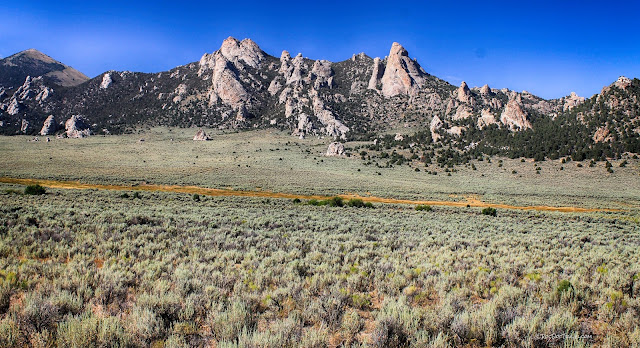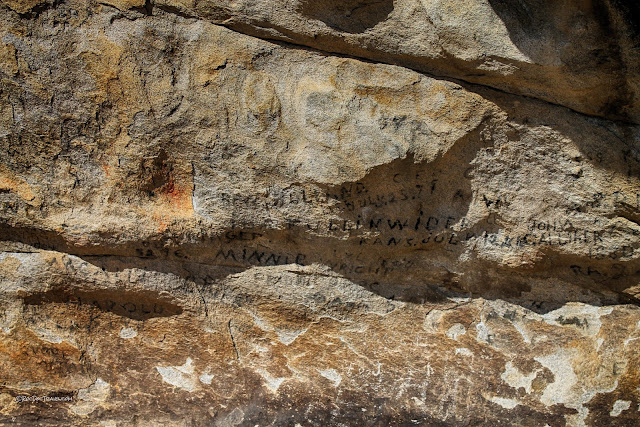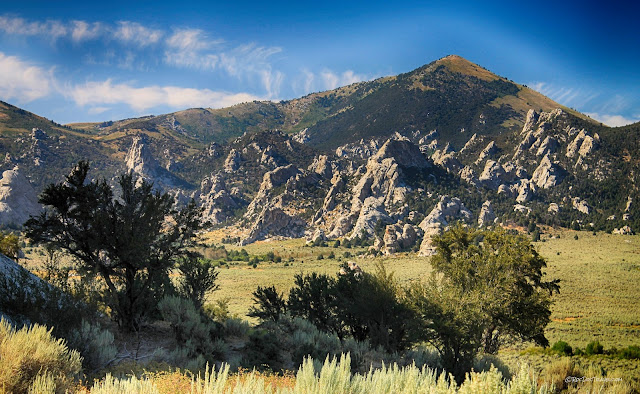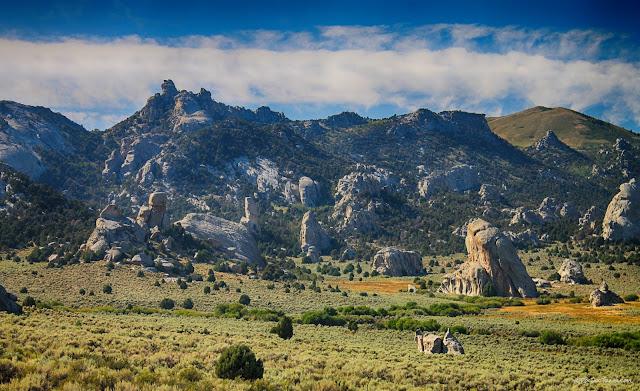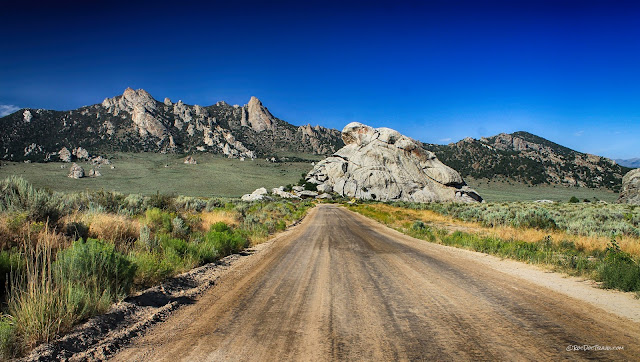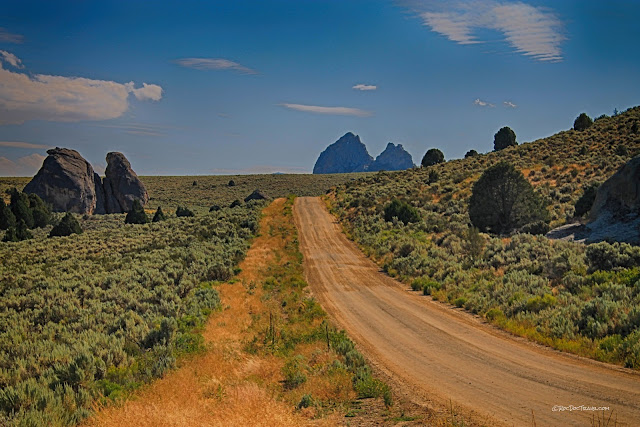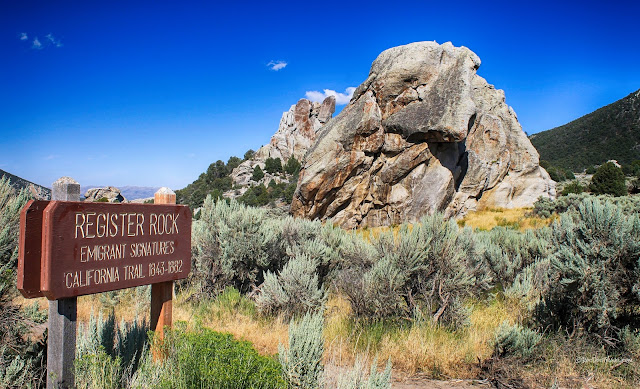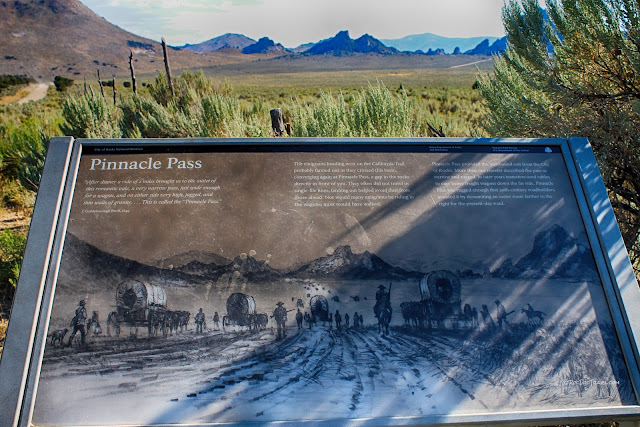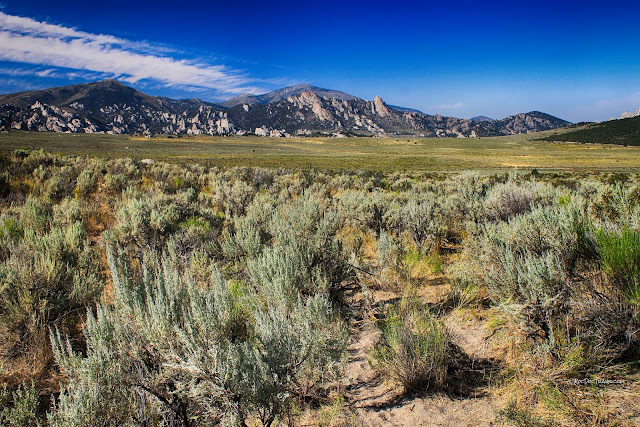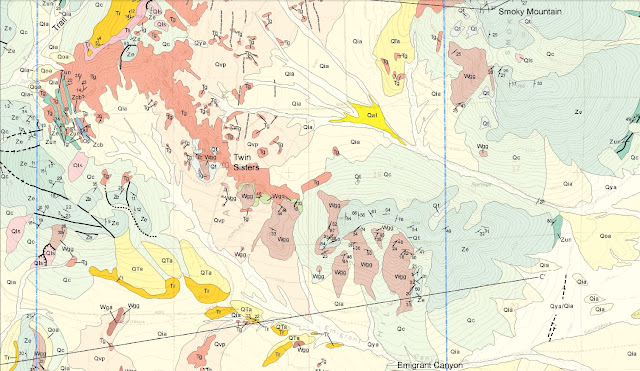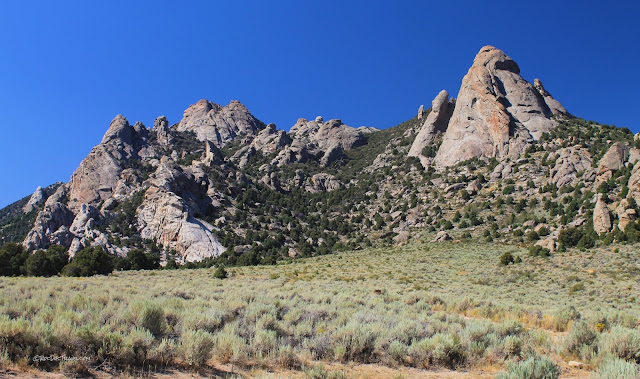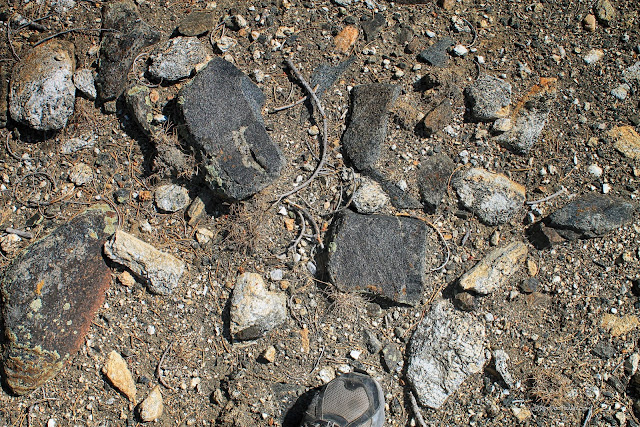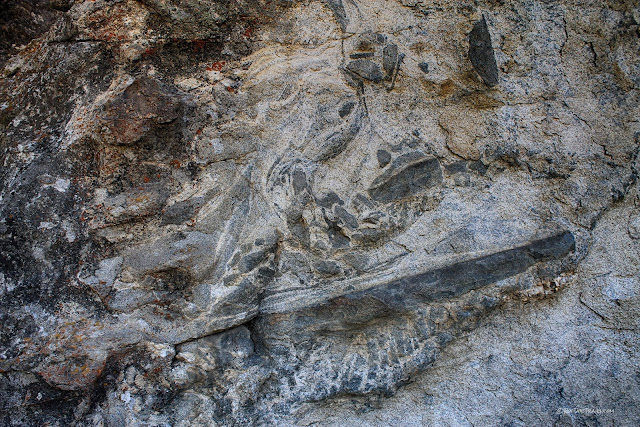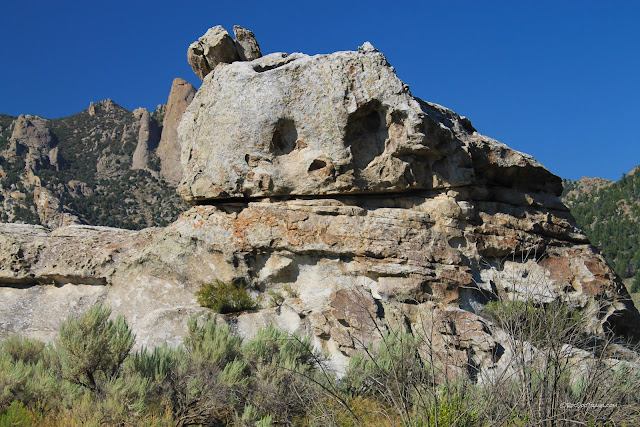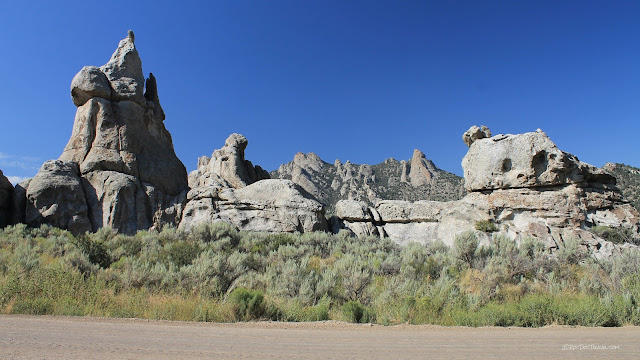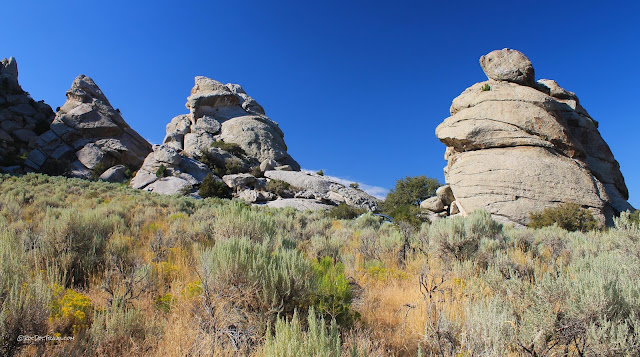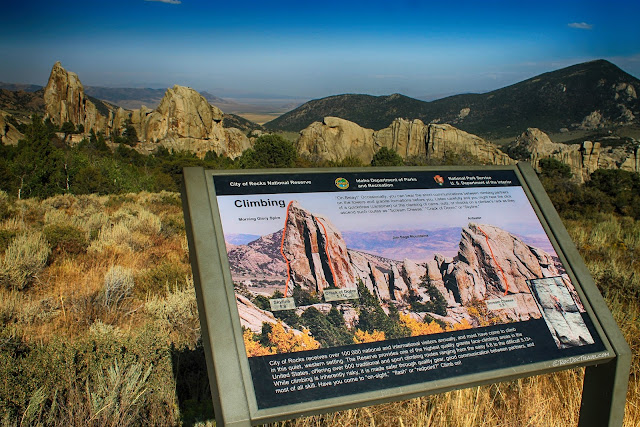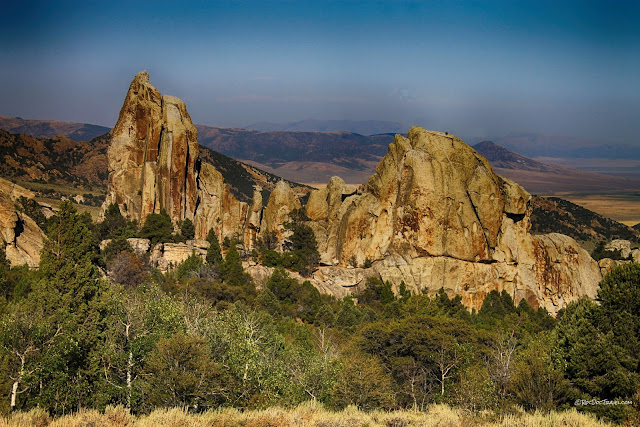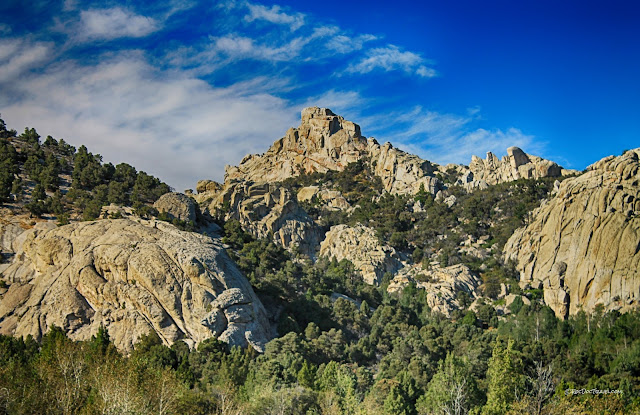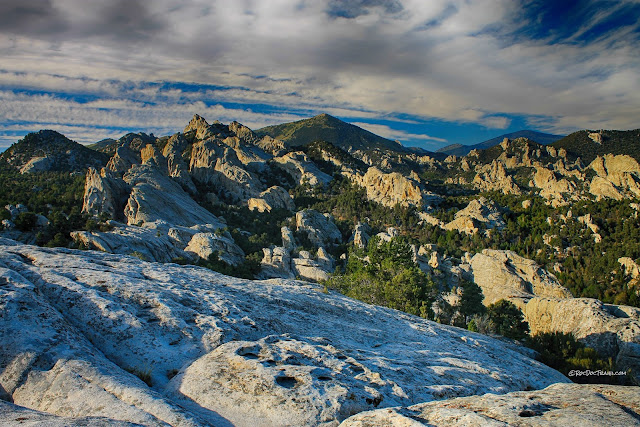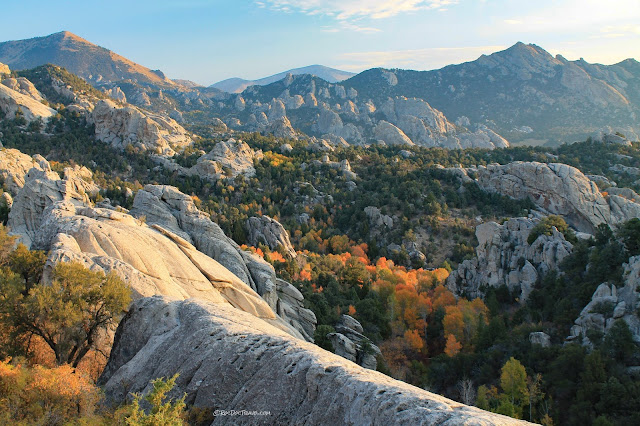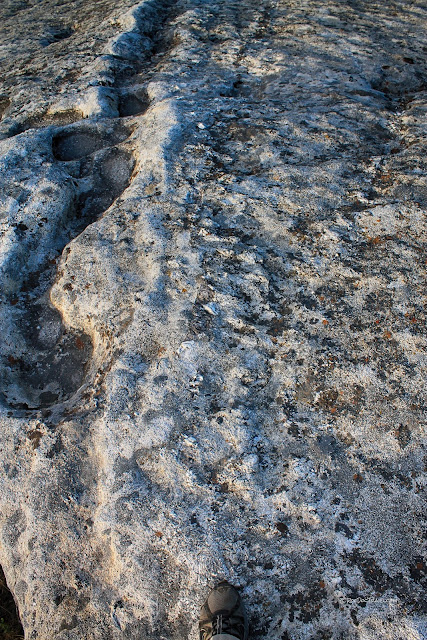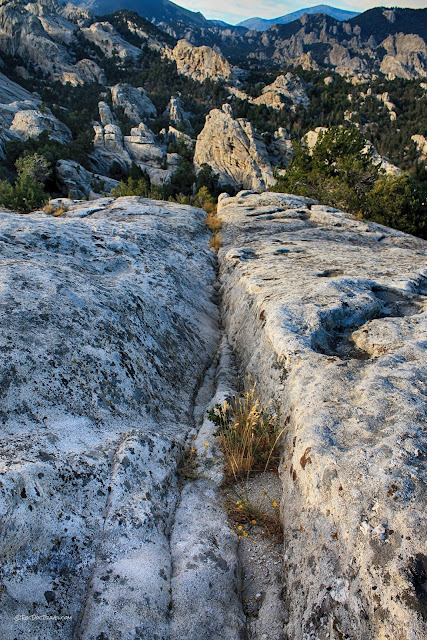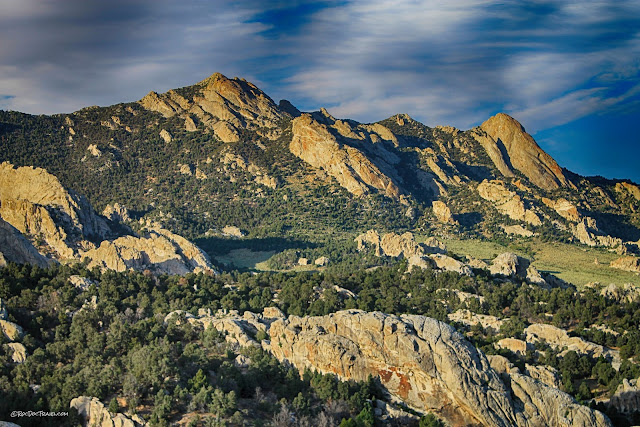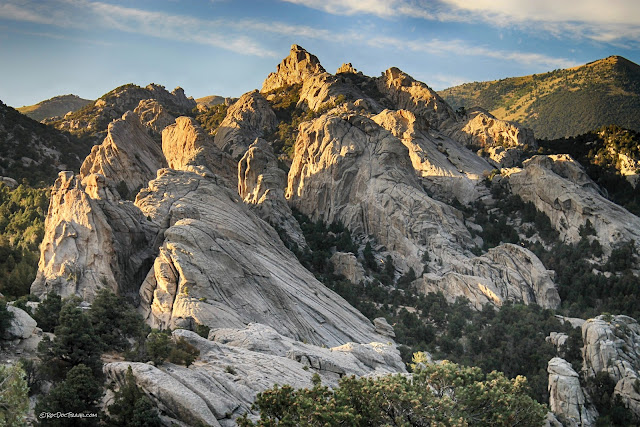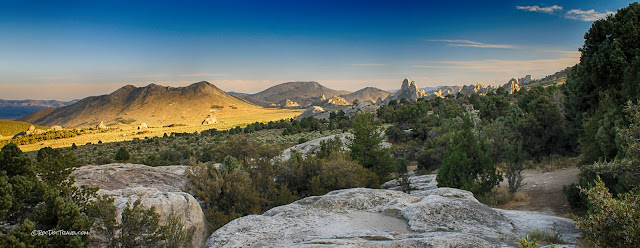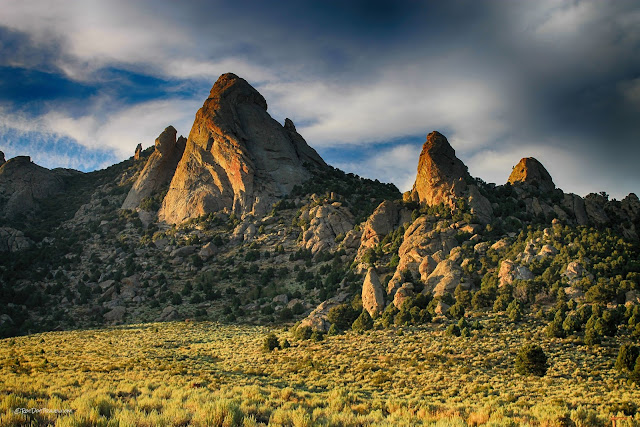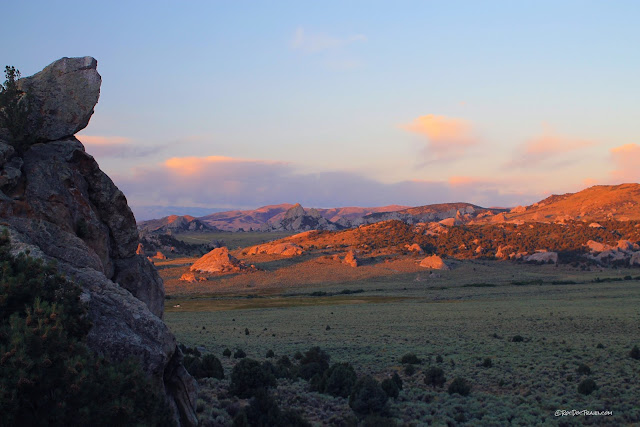City of Rocks, Idaho
City of Rocks National Reserve, Idaho
See two granite bodies a billion years apart eroded into spectacular towers and ridges -- on the California pioneer trail!Travel to City of Rocks
Interactive Google map
What's To See? City of Rocks is hiking and rock climbing paradise! The rocky terrain is unique and intriguing, and it's along the California Trail. See the website here.
Location: City of Rocks National Reserve is in a remote part of southern Idaho, not far from the Utah border, accessible some distance from I-84. The closest towns are Almo and Malta, Idaho.
Lodging: Campsites are available in the Reserve. The closest lodging is at Almo, Idaho. More choices are available farther north at Malta, Albion, and Burley.
Facilities: The Reserve has no facilities, so plan to bring your own food and water.
Seasons: City of Rocks has a lovely, dry climate with warm summers and spectacular Fall colors. The roads are often closed by snow in winter, so check with the website for current conditions.
Along the California Trail
About half a million people traveled by wagon, horse, or on foot across the Oregon trail from about 1840 to the 1880's. There are actually many branches along the trail between west-central Wyoming and the coast, including this branch that swings north out of Utah to avoid the perilous Great Salt Lake desert. Travelers on this road were mostly bound for northern California and southern Oregon. The trail to northern Oregon is farther north near the Snake River in Idaho.The City of Rocks National Reserve has a good website where you can learn more of its history, wildlife, and plants. I'll focus on the geology here.
This old farmhouse is a reminder of this region's heritage. Part of the park is still used for grazing cattle.
The main park road follows close to the California trail. It's easy to visualize wagons, horses, mules, oxen, farm animals, and pioneers trudging along the dusty trail through the sagebrush. Reading their journal entries is like repeating your own thoughts at seeing the rock wonders in this surprising little valley.
Geology of City of Rocks
The rocks on the skyline are billion year-old quartzite, which is a sandstone in which the sand grains have been fused together under pressure, forming a very hard, almost glassy brittle rock. The top of the granite is the tilted plane. Note that the quartzite is layered and tilted, whereas the granite below is unlayered.The City of Rocks offered a good rest-and-recuperation spot for the pioneers, with plenty of grass for the animals, fresh water, and a terrain that readily lends itself to recreation. Still today, you can't help but want to get out and explore!
The City of Rocks terrain was formed by a combination of unique factors. First is the granite bedrock that is quite resistant to erosion. Second is the abundance of fractures that accelerate erosion and weathering of the granite. And third is the variety of fracture orientations - vertical north-south fractures dominate, but there are others from vertical to nearly horizontal. Add the fact that this area is too far south and too low elevation to have been glaciated, and it looks like no other place (the Sierra Nevada has jointed granite bedrock, too, but it's all glaciated).
The western side of the park has the most interesting terrain to climb and explore, and that's where the campgrounds are. The pinion-juniper forest is lovely for easy hiking because of its lack of undergrowth. The plains of sage, antelope bitterbrush, and wildflowers aren't pleasant to walk through, but they make a scenic and fragrant foreground.
So how do these isolated granite rocks and towers form? It's tempting to think of them as boulders, not attached to anything, but in reality they are erosional remnants of a once-continuous body of granite. They are the lucky spots fortuitously fractured less than their neighbors, and were so much less subject to being weathered and eroded away. This granite has been at Earth's surface for something like 15 million years, which is plenty of time for water and ice to dissolve and break apart even such hard rocks as granite, turning them into sand. You can still see how this process is happening today where the fractures have widened out where the granite has washed away.
The view from Camp Rock. The center of the basin still provides good grazing. The herds of animals were of critical importance to the pioneers hoping to start new farms and ranches, and so all along the trail the path goes from water to water and grass to grass.
At Camp Rock, look for the fractures and notice how they are the center of attack by water, ice, and rock-eating lichen. They are the key to how City of Rocks formed.
Carving or painting your name on a prominent rock was a popular past-time of the pioneers, and I'm glad they did it. Seeing their names brings the trail alive. You can almost hear their excitement in the midst of such an incredible hardship as crossing the continent.
Where they are sheltered from rain and ice, the pioneer names are well-preserved. Where they carved into weathered (partially dissolved) granite, the etchings are fading fast.
Many people can trace their ancestry to the names carved on these rocks! Some of my own ancestors crossed the trail from Missouri and Iowa to the mountains of the west. How about yours?
What an inspiring landscape to rest in, even for a day or two! Graham Peak is the high spot. It is made of billion year-old sedimentary rocks that sit on top of the granite.
Looking eastward along the park road from Camp Rock.
I appreciate those who have taken the time and made the effort to research history, biology, and geology to put up signs in the parks. It's not a simple task, and takes expertise in the various fields, and artists to bring the information to life.
Here are a couple of views into the center of the valley from the trail.
The trail wound its way over this low summit to get to the southern exit.
Register Rock also holds the carvings and signatures of hearty pioneers.
The rock is also a good place to examine the role of fractures in break-down of the granite. The brown and black vertical stains are mineral deposits from rain, snowmelt, and dew. Dust sticks to the moisture, leaving traces behind that build up over the centuries.
The pioneer trail exited City of Rocks to the left of the widest pinnacle, as shown in the painting.
The pioneer trail crossed Pinnacle Pass just off the left edge of this photo. That way was too narrow, steep, and rocky for the modern road, so a new pathway was dynamited farther to the right. How tough were these pioneers that even modern machinery can't go where they took their animal-drawn wagons!
This is the view into City of Rocks from Pinnacle Pass. Sagebrush has long since obliterated the pioneer wagon ruts.
City of Rocks Granites
On the northeast side of the valley near the Circle Creek overlook, these towers are part of the 2.5 billion year old granite. The older granite resists erosion quite a bit better than the younger one. The boundary with the 28 million year old granite is at the left edge of the photo.
Panorama from Circle Creek overlook. The valley and isolated towers were eroded out of the younger granite. Something about its mineral composition and brittleness allows water and ice to work on it more effectively than on the older granite.
This panorama shows the old granite (the towers) with the quartzite (map unit Ze) on top of it on the far right. The Elba Quartzite (Ze) was deposited after milions of years of erosion had removed all other rocks from on top of Wgg and planed it off to horizontal. Then the Ze sand was deposited on top, and thousands of feet of additional sediments were deposited on top of that. Ze was probably buried under 3 to 8 km of sedimentary rocks for tens or hundreds of millions of years! Only in the last 17 or so million years was the area faulted and uplifted so that erosion could remove all that rock and expose the once-deep quartzite and granite. It's quite a story!
In places, you'll find dark ambphibolite dikes running through the old granite. It's also Archean in age, and represents a later magmatic episode in which much denser, darker rocks were melted and injected into the crust.
Here's a good exposure of the Elba Quartzite (Ze) near the park's east entrance. It overlies the granites, and is distinguished from a distance by its layering.
In some places, you can find interesting magmatic features, like this mixing of granite with amphibolite in Camp Rock.
Do you see a monstrous Pillsbury Dough Boy like I do? The "eyes" are spots where either the granite was a bit weak, or lichen focused its dissolving powers. Near Camp Rock.
These towers show both steep and nearly horizontal fractures in the younger granite.
The Tg granite weathers and erodes much more easily than the older Wgg granite, and these kinds of erosional remnants are the result.
The pinnacles close to Pinnacle Pass are the result of erosion along nearly vertical joints (fractures). The rocks in the foreground show shallow-dipping exfoliation joints.
In these rocks near Pinnacle Pass you can see light-colored dikes in the granite. They are made of quartz and feldspar that were injected along fractures after the main granite had cooled. It's often the case that there is still magma in the area after a granite has already solidified. If the granite is fractured by tectonic or uplift stresses, the younger granite can be injected into those fractures.
These three fractured granite sisters show the nearly horizontal fractures common in the park. They are similar to the "exfoliation" onion-like fractures in Yosemite. Exfoliation results from uplift and erosion, depressurizes the granite by removing great amounts of rock from off the granite. Brittle materials that expand break in layered fractures like these.
In the southern part of the park, this granite outcrop shows at least 5 different orientations of fractures.
Rock Climbing Paradise: City of Rocks
Climbers from all over flock to City of Rocks for the wide spectrum of difficulty levels - climbers from novice to awesome can all have a great time! On this dome, they have exfoliation to thank for the awesome shape, and the steep fractures for great pathways.
Some of the most popular and challenging climbing routes are on the west side of the park, accessible from the campgrounds. Notice the exfoliated tops and fractured sides of the towers and ridges.
The northwestern corner of the park has the highest elevations and densest forest.
Notice how the horizontal and vertical fractures interplay to create these inspiring shapes. Some of the most difficult climbing routes are on these rocks.
The park road climbs out the northwestern corner of the park. The great scenery just never quits.
The Archean granite Wgg wraps around the north side of the park just behind this unnamed peak. The fractures here are in many different orientations, reflecting the varied tectonic history they've undergone in the past 28 million years.
This intriguing tower stands near the summit of the park's northwestern road.
View from the northwestern road summit back into the City of Rocks.
When you visit, be sure to be there for a sunrise and a sunset. This is sunset from the west-side rocks near the campgrounds. The surface in the foreground is an exfoliation surface, one of the nearly horizontal fractures. The ridges in the distance were formed along north-south trending vertical fractures.
City of Rocks is particularly beautiful in Fall!
Large feldspar minerals are concentrated along this dike. Lichen obscure the view a bit.
Exploring the bedrock is the best way to learn how the erosional features formed. Here, for example, you can see how the granite along this fracture is being slowly weathered away. Eventually, this will become another wide fracture separating two granite ridges.
City of Rocks Sunrise and Sunset
I was lucky enough to see this gathering of about 50 hawks soaring on the evening updrafts. It was one of the most amazing things I've seen on one of my trips. I shall call it "The Gathering of Hawks in the City of Rocks."
Low sun angles bring out the textures of the bedrock formed by fractures and erosion. The skyline granites are Wgg, the 2.5 billion year-old granite on the northeastern side of the park. Note the whitish dikes in them.
Southward view of towers on the park's west side.
Northeastward wide view in the sunset.
Sunset, rocks, and hawks.
The low sun angle really helps you see the vertical fractures in contast to the low-angle exfoliation surfaces.
One more look at The Gathering of Hawks.
Southward view in the sunset.
Sunset view of the Archean granite Wgg from Circle Creek overlook. This granite stands higher and steeper than the younger, more erosion-prone granite Tg.
The next several pictures are sunrise from near Circle Creek overlook. The skyline on the right side is the older granite. Other outcrops are the younger granite.
Looking west across the valley.
Be sure to get up for the sunrise - it'll be worth it!
